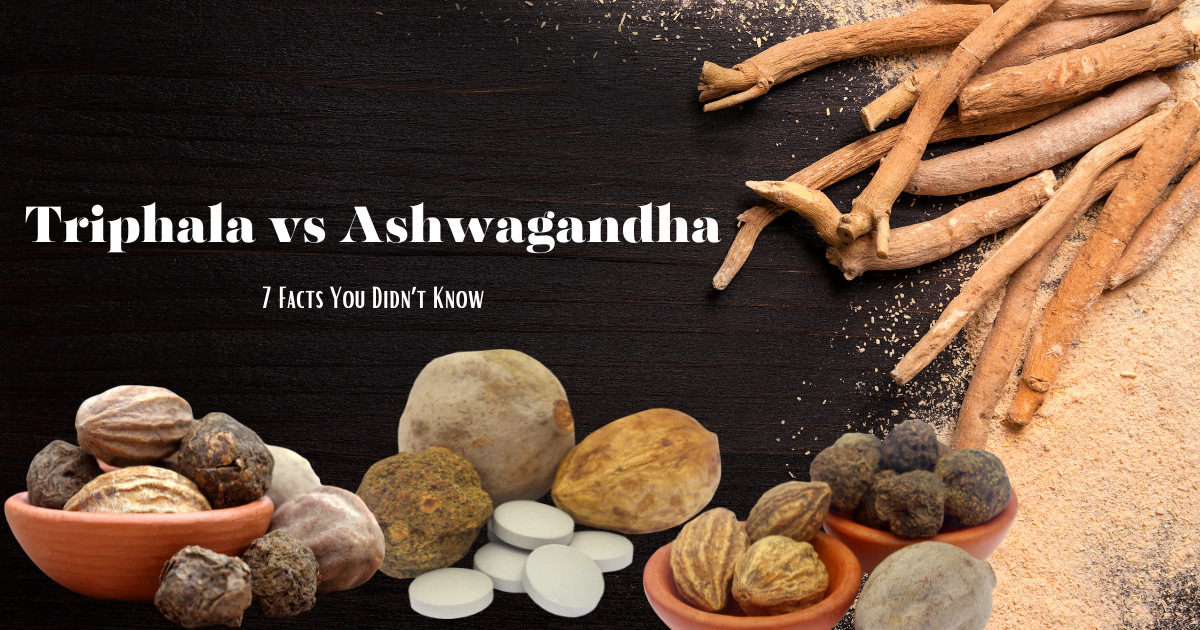When is the best time to take Triphala for weight loss? When looking for natural ways to improve your health and manage your weight, two names are likely to frequently come up: Triphala and Ashwagandha root. And that’s no surprise. These herbal supplements have gained in popularity for their health benefits.
When choosing a supplement for weight loss, it’s crucial to select the right one. Triphala, known for its natural detoxifying properties, can be effective at the right time. While Ashwagandha plays a slightly different, yet somewhat complementary role in our findings.
It’s important to consider your body’s needs and lifestyle when deciding between supplements like Ashwagandha Root and Triphala.
Let’s delve into the unique qualities of Ashwagandha and Triphala in this comparison, and focus on revealing the best time to take Triphala for weight loss.
Join us as we explore these natural wonders and help you make informed decisions on your health journey.
Table of Contents
Understanding Ashwagandha Root
One of the most respected herbs in Ayurveda is Ashwagandha. It is an upright, greyish subshrub with small orangish-red berries that contain yellow, kidney-shaped seeds.
The plant also has tiny yellow or greenish flowers. Growing three to five feet tall, it is found to primarily grow on what most people would consider waste ground, such as vacant lots, tracts of land that don’t seem to get used for anything, and building sites that have been abandoned for some time. But that’s not the only place. It is also cultivated and harvested on carefully managed land for commercial purposes.
It is the root and leaf of the plant which are most frequently used for therapeutic purposes. 1
Scientifically known as Withania somnifera, Ashwagandha is native to parts of Asia, Africa, and Europe. It is also known as winter cherry, dunal, Solanaceae, or Indian ginseng. However, it is important to note that it is not part of the ginseng family. 2
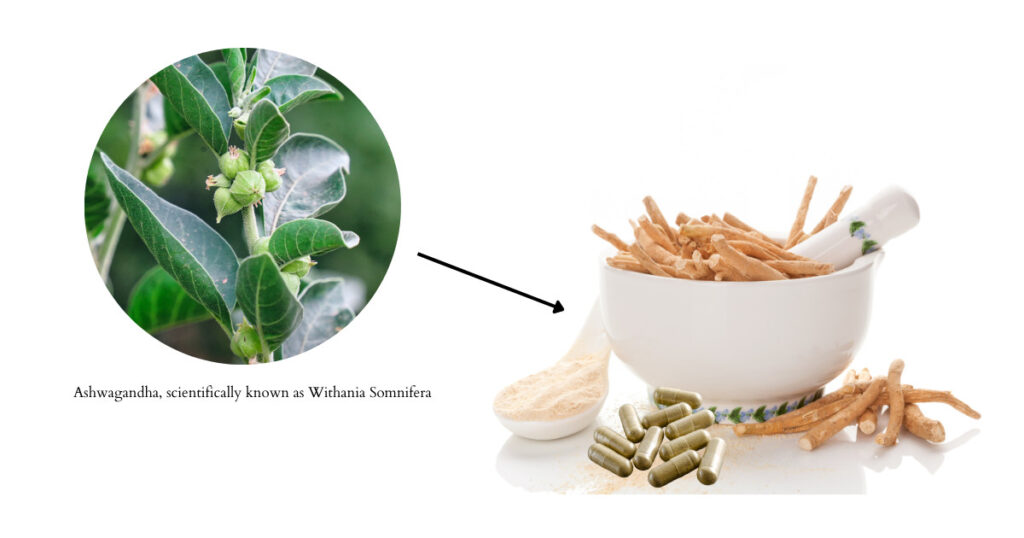
It has been used in the holistic healing system for over 6,000 years to promote longevity, ease stress, and alleviate constipation. Also popular in Western countries, it is offered as a topical treatment or dietary supplement. 3
Amazing Health Benefits of Ashwagandha
Although there are numerous Ashwagandha benefits, research is ongoing and it has been shown to potentially support mental and physical health in areas such as:
- Stress and anxiety reliever 4 5
- Lowers blood sugar to those who have type 2 diabetes 6
- Increase in muscle power and improves strength 7
- Improves libido in women 8
- Enhances fertility and testosterone levels in men 9 10
- Improves memory and concentration, and 11
- Promotes cardiovascular health 12
Remember that even though Ashwagandha has many health advantages, you should always speak with your doctor before starting a new supplement therapy, particularly if you have any existing medical concerns or are taking other medications.
The same is to be said for Triphala given we are looking at the best time to take Triphala for weight loss in this article.
Ashwagandha for Weight Management
Losing weight is an ever-changing process as you move through stages of life. A weight loss journey cannot be rushed. All of the lifestyle factors that could be affecting your health should be taken into account.
You may wish to check out another article we published on some of the weight loss challenges and why you can’t lose weight.
Ashwagandha has demonstrated significant potential in aiding weight loss, particularly in individuals experiencing chronic stress. This is where we find the value for Ashwagandha comes into the weight loss discussion with strength.
According to a placebo-controlled trial by D. Choundhary et. al., Ashwagandha root extract can effectively reduce psychological and physiological markers of stress, which in turn assists in weight management. The reduction in stress hormones like cortisol contributes to decreased visceral fat accumulation, thereby promoting weight loss. 13
Additionally, M. Watanabe et. al, conducted a pilot study on the effect of weight loss on Withania somnifera and suggested that when combined with other natural supplements like Cinnamon (CC in the table shown below), Ashwagandha (AW in the table shown below) enhances weight loss in overweight and obese patients. 14
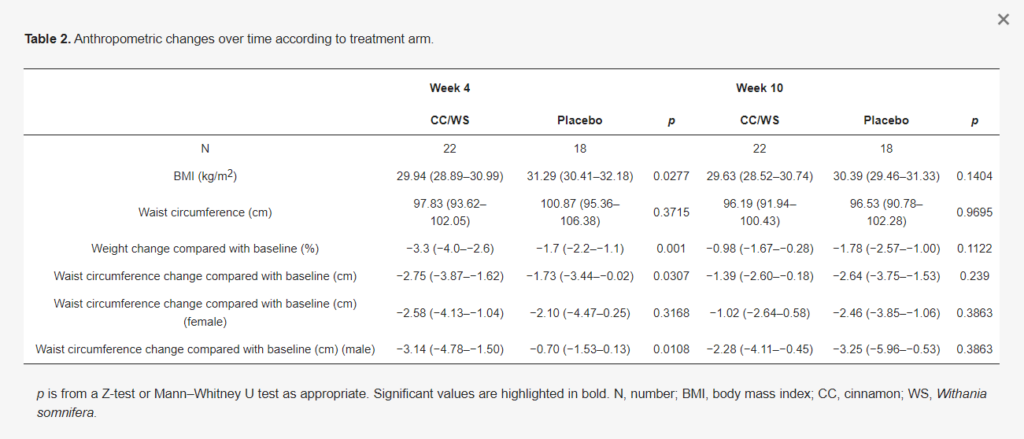
A research article on the guide to using Ashwagandha for weight management further supports the role of Ashwagandha in supporting weight loss, specifically, highlighting its ability to reduce cortisol levels, improve muscle growth, and regulate testosterone levels. All of which are contributing factors to weight loss and overall metabolic health. 15
Personal Experiences with Ashwagandha
Individuals who have used Ashwagandha report a range of experiences, highlighting the herb’s adaptogenic properties.
Users of this herb describe feeling tangible effects within just two days of use, including increased energy, improved focus, reduced stress, heightened drive, and a more grounded mindset. Suggestions have been made that Ashwagandha could be especially beneficial for those dealing with chronic stress. 16
Other users expressed strong preferences for Ashwagandha, noting its calming and stabilising effects. Their anecdotal accounts mention a noticeable heart-strength improvement after three months of consistent use. This is reportedly related to both tincture and powder forms.
However, like with many things in the holistic world, experiences can vary significantly. Not everyone reports that they notice positive effects with products like Aswagandah. It’s something that is a case-by-case thing depending upon needs and circumstances.
When carefully blended with other herbs, like in Ultimate Fibre, many say that the benefits can be amplified.
Side Effects of Ashwagandha
Ashwagandha is generally considered safe for most people. But like vitamin supplements, some people may experience negative effects from it. Some of the potential side effects of Ashwagandha may include:
- Digestive Issues
- Some people might experience digestive discomfort, including diarrhea and upset stomach, especially when taken in high doses. 17

- Sedative Effects
- Ashwagandha can induce drowsiness, given its calming properties. This may interfere with activities that require alertness, such as driving. 18
- Allergic Reactions
- Although rare, allergic reactions such as rashes, itching, or breathing difficulties can occur, particularly in those allergic to plants in the nightshade family. 19
- Interactions with Medications
- Ashwagandha may interact with certain medications, especially those for thyroid, blood sugar, and blood pressure, and those that suppress the immune system. 20
- Pregnancy and Breastfeeding
- Due to a lack of sufficient research, it is advised that pregnant or breastfeeding women avoid using Ashwagandha because it might affect the fetus and the mother’s health.
- Thyroid Hormone Interference
- Blood Sugar and Blood Pressure Changes
- Immune System Effects
- Since Ashwagandha can boost the immune system, it might exacerbate symptoms in people with autoimmune diseases like rheumatoid arthritis, lupus, or Hashimoto’s thyroiditis. 24
General Use of Ashwagandha
The general use of Ashwagandha, as outlined on Drugs.com, indicates that the root powder of Ashwagandha is typically used daily ranging from 120 mg to 2 g, often in combination with other preparations.
For anxiety, it ranges from 125 mg to 12,000 mg per day. Qualified specialists may suggest:
- 300 mg of Ashwagandha root extract taken twice daily for 10 weeks
- standardised Ashwagandha extract at 240 mg once daily for 60 days
- 500 mg twice daily (initially starting at 250 mg twice daily and increasing in week two) for 12 weeks
For improving sleep quality, typically 300 mg of Ashwagandha root extract is taken twice daily for a period of 10 to 12 weeks as suggested by research.
Please note that all information here is provided for educational and illustrative purposes only. None of it is to be considered medical advice. The effectiveness and safety of Ashwagandha can depend on your health status and other variables. Therefore, consulting with a healthcare provider before starting Ashwagandha, especially if you are considering specific quantities related to particular health conditions, is wise.
Exploring the World of Triphala
Triphala, a traditional Ayurvedic formulation, is a renowned polyherbal medicine consisting of dried fruits from three plant species:
- Amalaki or Indian Gooseberry, scientifically known as Emblica officinalis 25
- Haritaki, also known as Terminalia chebula
- Bibhitaki, also known as Terminalia bellerica Roxb.
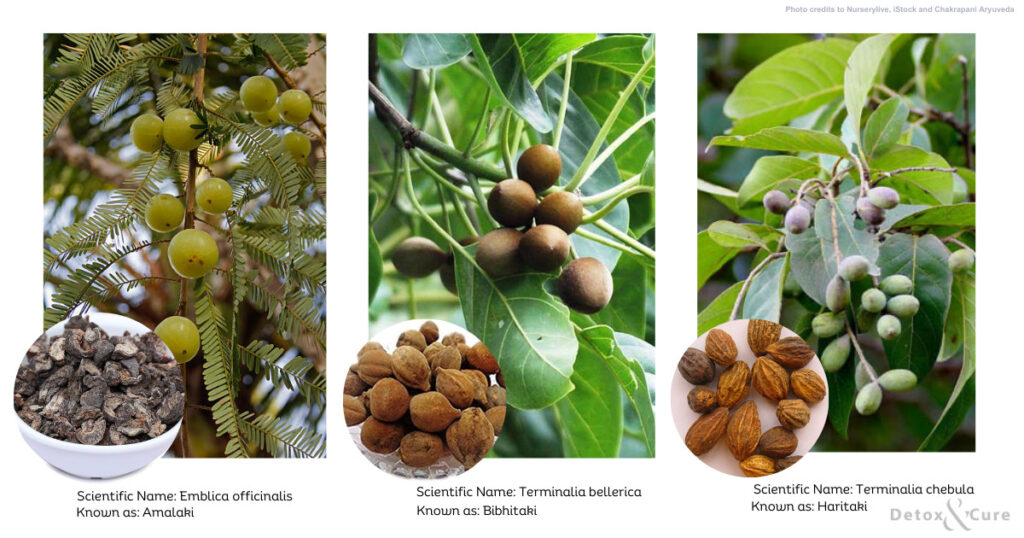
These plants are native to the Indian subcontinent. The word ‘Triphala’ itself is derived from Sanskrit, where ‘tri’ means three and ‘phala’ means fruits, aptly describing this combination. 26
Triphala holds a significant place in Ayurvedic medicine and is classified as a Tridoshic Rasayana, a term in Ayurveda that implies its balancing and rejuvenating properties for all three doshas (Vata, Pitta, and Kapha), which are the primary life forces or energies in Ayurvedic philosophy. 27
Charak, a great physician in ancient India, respected Triphala for its potential to promote longevity and rejuvenation, even suggesting that its daily consumption together with honey and ghee could lead to a hundred years of life free from old age and diseases. Similarly, the physician Sushrut recognised its therapeutic value in treating ulcers and wounds. 28
Over the centuries, Triphala has remained a cornerstone of gastrointestinal treatment and a revered therapeutic agent in Ayurvedic medicine, often considered a panacea for various health conditions due to its comprehensive health-promoting qualities.
How is Triphala Processed?
In the production of Triphala, Amalaki, Bibhitaki, and Haritaki are processed and powdered separately. Each fruit contributes its unique therapeutic properties to the formulation, which are then synergistically enhanced when combined.
The standard preparation involves mixing the powders of these three dried fruits in equal proportions.
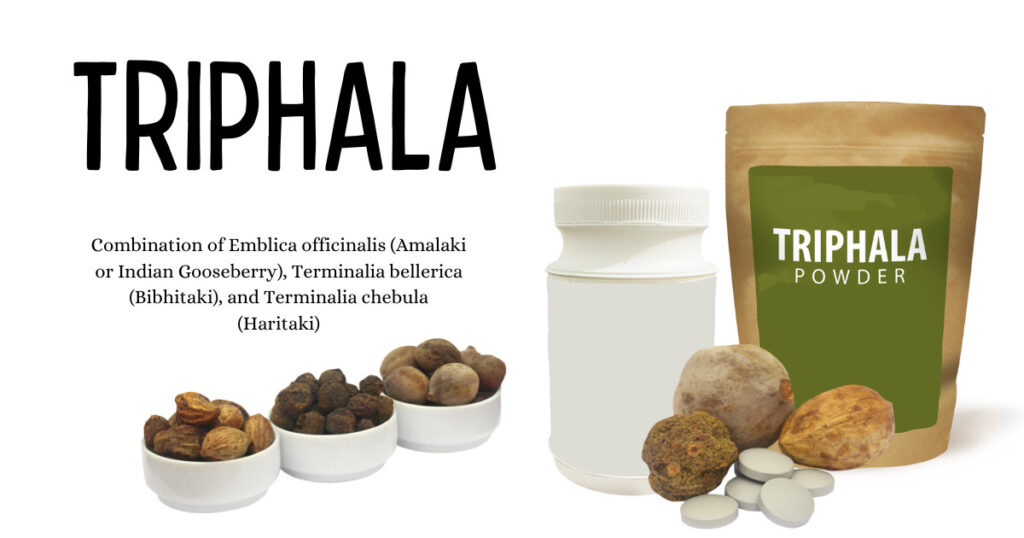
This specific ratio is crucial as it ensures a balanced effect on the three doshas according to Ayurvedic principles. 29
The process begins with the careful selection and authentication of the fruits, ensuring their quality and purity. The fruits are then dried, and the dried fruits are ground into a fine powder.
The powders are sieved to attain a uniform consistency before being mixed in the precise one-to-one-to-one ratio, forming the final Triphala churna (powder).
This churna is what is commonly used in various therapeutic applications within Ayurveda and to enhance its shelf life. These churnas are often converted into gutikas (tablets).
Ayurvedic practice frequently recommends using guggul, a well-known substance known for its anti-inflammatory and lipid-lowering properties, as a binding agent in these tablets.
Guggulkalpa, a term used in Ayurveda, refers to tablets that contain equal or greater amounts of guggul compared to other ingredients. 30
For the manufacturing of tablets like Triphalaguggulkalpa, modern techniques such as wet granulation, dry granulation, or direct compression are employed.
These processes are followed by quality control tests like weight variation and disintegration tests. The direct compression method offers several advantages, including uniformity, reduced steps and costs, and physical stability of the product. 31
Uses of Triphala
Triphala is frequently used in Ayurveda to address a variety of medical conditions for the beneficial properties it brings, including it being:
- anti-inflammatory 32
- laxative 33
- anti-arthritic 34
- antiviral 35
- analgesic 36
- hypoglycemic 37
- anti-ageing 38
- antimicrobial 39

Is Triphala Good for You?
May devotees of Triphala would offer up a resounding ‘Yes’ to this question. But, does that mean it is good for everyone? Before we join them in singing the praises of this trio, let’s take a little closer look at the benefits.
The Benefits of Triphala
Let’s take a closer look at some of the applications this is used for.
| Dental Care | In periodontal therapy, Triphala are used as oral rinses. Triphala can be used as a gargling agent for dental conditions. Studies have shown that although there was no sign of tooth structure remineralisation, a 0.6% Triphala mouthwash has demonstrated strong anti-caries action that is comparable to chlorhexidine’s without having the same drawbacks, such as tooth discolouration, and at a significantly lower cost. 40 |
| Stress and Anxiety Relief | Triphala helps in managing stress and anxiety primarily through its antioxidant and anti-inflammatory properties. Its constituents, such as gallic acid, ellagic acid, and chebulic acid, interact with key brain neurotransmitter systems like serotonin (5-HT) and brain-derived neurotrophic factor (BDNF), which are crucial in regulating mood and stress responses. These actions contribute to improved resilience against stress-induced psychological disorders, including depression and anxiety. 41 |
| Liver Health | Triphala, through its rich content of tannins and other polyphenolic compounds, exhibits potent antioxidant properties, which are important in mitigating oxidative stress in liver cells. It enhances the body’s natural antioxidant defenses by increasing the activities of superoxide dismutase and glutathione peroxidase, and decreasing lipid peroxidation, thereby protecting the liver from damage and supporting its health and function. 42 |
| Gut Health and Constipation Relief | Triphala treats and helps constipation and digestion primarily through its laxative properties. It increases bowel movement frequency and improves stool form by facilitating easier bowel evacuation. Triphala’s synergistic effects from its various ingredients enhance gastrointestinal motility, contributing to better digestive health and relief from constipation symptoms. 43 |
| Blood Sugar Control | It has been shown that Triphala helps in treating diabetes. It promotes pancreatic stimulation, which increases insulin secretion. Triphala has been studied to significantly lower blood glucose levels and to include chemicals that accelerate insulin-stimulated glucose absorption without converting or storing the glucose in fat within cells. 44 |
| Skin Health | Triphala benefits the skin by exhibiting strong antioxidant properties and protecting skin cells from oxidative stress. It enhances the production of collagen, a key structural protein for maintaining skin elasticity and firmness, and increases the synthesis of skin barrier proteins like involucrin and filaggrin. This contributes to improved skin hydration, reduced signs of aging, and overall skin health. 45 |
| Eye Care | Triphala is another amazing natural product for eye health. Eye disorders can be effectively treated and clear eyesight maintained using Triphala eyewash. Dry eyes, computer vision syndrome, cataracts, age-related macular degeneration, conjunctivitis, and glaucoma can all be successfully avoided with it. 46 |
| Cancer Preventative Potential | Triphala has been shown in tests on cancer to have potential anticancer properties. Gallic acid, the primary constituent, has the potential to inhibit the growth of cancer cells. It has been discovered that while Triphala does not affect normal breast cells, it decreases the chance of survival of breast cancer cells. 47 |

Triphala’s diverse range of benefits, from oral health to cancer prevention, underscores its significance in traditional medicine. Its natural composition and wide-ranging effects make it a valuable herbal remedy in contemporary health care.
Best Time To Take Triphala For Constipation
Triphala works by naturally stimulating bowel movements, ensuring smooth passage without causing dependency or harsh effects. It balances the gut environment and aids in efficient digestion, addressing the root cause of constipation.
Timing is key when using Triphala for constipation. The best time to take it is Madhyabhakta, which in Ayurveda means ‘in between meals’, particularly during the mid-morning or mid-afternoon. This timing is important as it aligns with the body’s natural digestive cycle, allowing Triphala to work effectively in harmonising gut health. 48
Also, taking Triphala with lukewarm water enhances its laxative properties, making it even more effective.
Best Time to Take Triphala for Weight Loss
Managing weight can be a challenging journey for many. It often involves a balance between diet, exercise, and lifestyle choices. Among various natural remedies, Triphala has emerged as a promising aid in weight loss.
Due to its ability to remove toxins from the body, Triphala supports the health of the stomach, small intestine, and large intestine. It serves as a colon toner and aids in toning and strengthening the colon’s tissue. This therefore helps in controlling an individual’s weight.
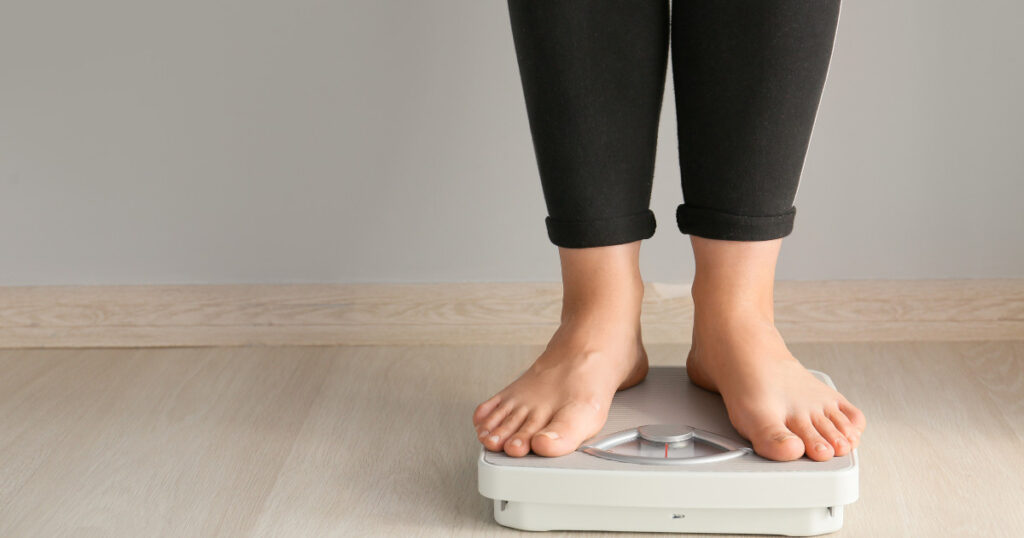
Triphala aids in digestion, helps in the natural detoxification process, and improves metabolism. These factors collectively contribute to weight loss. It’s known to reduce fat accumulation in the body and enhance the breakdown of fats, making it a valuable component in weight management. 49
For weight loss, the timing of taking Triphala plays an important role. The best time to consume Triphala for aiding weight loss is on an empty stomach, either early in the morning or just before bed. In the morning, it kick-starts metabolism and supports the body’s natural cleansing processes. 50
At night, its laxative property aids in detoxification and prevents the accumulation of toxins, which are often a barrier to weight loss.
How to Take Triphala
There are many ways to consume Triphala: as capsules, powder, tincture, tea, mouthwash, oils, and even juice. One half-teaspoon serving of Triphala powder is normally taken daily. The best results are found when pouring a cup of boiling water over it to create tea.
You could try incorporating the powder—which has a bitter flavour—into a drink, smoothie, or tea.
Triphala is normally consumed as:
- Powder
- Average: 2 to 4 grams twice daily 51
- Higher: 4 to 5 grams three times daily
- To make tea, mix the powder with boiling water and use it in smoothies, juices, or tea due to its bitter taste.
- Capsule
- General: 1 to 2 capsules twice a day
- Juice
- 2 to 3 teaspoons once or twice a day
With the consumption tips provided above, it is very important to remember that even though Triphala is a natural and efficient health treatment, it needs to be taken at the appropriate times and in the appropriate quantity. Seeking specialist advice is a good idea.
The Downside of Triphala
Even though we are looking at the best time to take Triphala for weight loss, you should be aware that complications with health may result from consuming Triphala than is normally discussed. This is normally the result of using too much. The Triphala side effects that you really should be aware of include:
- Digestive health issue
- As a mild laxative, Triphala can have a variety of gastrointestinal side effects, including cramps, diarrhea, upset stomach, and gas. 52
- Pregnancy Issues
- One of the components of Triphala, Haritaki, is thought to be the reason why pregnant women miscarry and can harm the developing baby. It has also been linked to numerous other negative effects for expectant mothers. 53
- Lowers blood pressure excessively
- Triphala lowers blood pressure by reducing inflammation. With this, if taken too much, this might lower blood pressure even more. 54
- Can trigger allergic reactions
- Some people may experience allergic reactions when using Triphala. These reactions can include hives, swelling, itching, and other symptoms, as well as more serious symptoms like breathing difficulties. 55
Due to its many health benefits, Triphala has been used for generations. But it’s also important to be aware of Triphala churna’s potential negative consequences, which are primarily linked to excessive consumption. It is very important to be extra cautious when considering using it.
FAQs
Can You Take Triphala Long Term?
Taking Triphala long-term is generally considered safe for most people. Its natural composition and balancing properties can make it suitable for prolonged use. However, it’s always wise to consult with a healthcare professional, especially if you have underlying health conditions or are taking other medications, before making this a part of your routine.
Is it better to take Triphala in the morning or at night?
The optimal time to take Triphala depends on your specific health goals. For digestive health and regular bowel movements, taking Triphala at night before bed can be beneficial. It works overnight to aid digestion and cleanse the gut. If you’re using it for other health benefits like boosting immunity or overall rejuvenation, taking it in the morning can be effective. The best time to take Triphala for weight loss is in the morning, on an empty stomach, or just before bed.
Is Triphala a fat burner?
Triphala isn’t primarily a fat burner, but it can aid in weight loss indirectly. Its detoxifying properties and ability to improve digestion can contribute to a healthier metabolic rate and assist in weight management. However, it should be accompanied by a balanced diet and regular exercise for effective weight loss.
Does Triphala cleanse the gut?
Yes, Triphala is well-known for its gut-cleansing properties. It gently detoxifies and cleanses the digestive tract, improves bowel movement regularity, and enhances overall gut health. Triphala’s natural laxative effect helps in removing toxins and can provide relief from constipation, making it a valuable addition to a gut health regimen. [26]
What can I consider instead of Triphala?
If you are looking for something as an alternative that offers similar gut health and weight loss potential, take a closer look at Sea Moss. We took a closer look at Fucoxanthin, which comes from certain seaweeds, like Sea Moss, in an older article that considers the question; is seaweed good for losing weight?
Conclusion
As we’ve explored some incredible facts about Ashwagandha and Triphala, it’s clear that each has its unique benefits.
When it comes to Triphala, timing can be everything. The best time to take Triphala is usually at night before bed, especially if you’re using it to aid digestion or promote regularity. This timing helps your body to use its detoxifying effects effectively while you rest.
But remember, everyone’s body reacts differently, so it’s always wise to consult with a healthcare professional about what works best for you.
Are you intrigued to learn more about such fascinating insights? Join our community and be a part of the conversation on Instagram and Pinterest and share your thoughts on the best time to take Triphala for weight loss.
References
- “Ashwagandha Withania Somnifera family: Solanaceae” – G. Engels, J. Brinckmann, Last checked 16 January 2024 [American Botanical Council] [Archive] ↩︎
- “Withania somnifera” – Plants of the World Online Staff, Last checked 16 January 2024 [Plants of the World Online] [Archive] ↩︎
- “An Overview on Ashwagandha: A Rasayana (Rejuvenator) of Ayurveda” – N. Singh, M. Bhalla, P. de Jager, M. Gilca, Last checked 16 January 2024 [African Journals Online] [Archive] ↩︎
- “An Alternative Treatment for Anxiety: A Systematic Review of Human Trial Results Reported for the Ayurvedic Herb Ashwagandha (Withania somnifera)” – M. Pratte, K. Nanavati, V. Young, C. Morley, 1 December 2024 [PubMed Central] [Archive] ↩︎
- “An investigation into the stress-relieving and pharmacological actions of an ashwagandha (Withania somnifera) extract” – A. Lopresti, S. Smith, H. Malvi, R. Kodgule, 13 September 2019 [PubMed Central] [Archive] ↩︎
- “Hypoglycemic, diuretic and hypocholesterolemic effect of winter cherry (Withania somnifera, Dunal) root” – B. Andallu, B. Radhika, Last checked 16 January 2024 [PubMed] [Archive] ↩︎
- “Effects of Withania somnifera (Ashwagandha) and Terminalia arjuna (Arjuna) on physical performance and cardiorespiratory endurance in healthy young adults” – J. Sandhu, B. Shah, S. Shenoy, S. Chauhan, G. Lavekar, M. Padhi, Last checked 16 January 2024 [PubMed] [Archive] ↩︎
- “Efficacy and Safety of Ashwagandha (Withania somnifera) Root Extract in Improving Sexual Function in Women: A Pilot Study” – S. Dongre, D. Langade, S. Bhattacharyya, 4 October 2015 [PubMed Central] [Archive] ↩︎
- “Examining the Effects of Herbs on Testosterone Concentrations in Men: A Systematic Review” – S. Smith, A. Lopresti, S. Teo, T. Fairchild, 5 July 2020 [Science Direct] [Archive] ↩︎
- “Ashwagandha for Male Infertility” – S. Tais, 2 April 2014 [Natural Medicine Journal] [Archive] ↩︎
- “Effect of standardized aqueous extract of Withania somnifera on tests of cognitive and psychomotor performance in healthy human participants” – U. Pingali, N. Fatima, R. Pili, Last checked 16 January 2024 [ResearchGate] [Archive] ↩︎
- “A double-blind, randomized, placebo-controlled trial on the effect of Ashwagandha (Withania somnifera dunal.) root extract in improving cardiorespiratory endurance and recovery in healthy athletic adults” – S. Tiwari, S. Gupta, A. Pathak, 1 November 2019 [Science Direct] [Archive] ↩︎
- “Body Weight Management in Adults Under Chronic Stress Through Treatment With Ashwagandha Root Extract” – D. Choudhary, S. Bhattacharyya, K. Joshi, 6 April 2016 [PubMed Central] [Archive] ↩︎
- “Effect on Weight Loss of an Oral Supplement Containing Cinnamon Bark (Cinnamomum cassia) and Withania somnifera in Adult Patients with Overweight and Obesity: A Pilot Study” – M. Watanabe, A. Laviano, A. Balena, A. Vitaterna, E. Angeloni, R. Toscano, G. Natoli, C. Lubrano, L. Gnessi, 2 September 2023 [MDPI] [Archive] ↩︎
- “Body Weight Management in Adults Under Chronic Stress Through Treatment With Ashwagandha Root Extract: A Double-Blind, Randomized, Placebo-Controlled Trial” – D. Choudhary, S. Bhattacharyya, K. Joshi, 6 April 2016 [PubMed] [Archive] ↩︎
- “My experience with Ashwagandha Root” – Grow Network Staff, Last checked 16 January 2024 [Grow Network] [Archive] ↩︎
- “Ashwagandha: Is it helpful for stress, anxiety, or sleep?” – NIH Staff, Last checked 16 January 2024 [National Institutes of Health] [Archive] ↩︎
- “Ashwagandha” – Drugs.com Staff, 1 November 2023 [Drugs.com] [Archive] ↩︎
- “Ashwagandha side effects: What you need to watch out for” – K. Umipig, 29 June 2023 [Longetivity Technology] [Archive] ↩︎
- “Ashwagandha – Uses, Side Effects, and More” – WebMD Staff, Last checked 16 January 2016 [WebMD] [Archive] ↩︎
- “Ashwagandha as a Unique Cause of Thyrotoxicosis Presenting With Supraventricular Tachycardia” – H. Kamal, K. Patel, A. Brdak, J. Heffernan, N. Ahmad, 25 March 2022 [PubMed Central] [Archive] ↩︎
- “Hypoglycaemic and Hypolipidaemic Effects of Withania somnifera Root and Leaf Extracts on Alloxan-Induced Diabetic Rats” – R. Udayakumar, S. Kasthurirengan, T. Mariashibu, M. Rajesh, V. Anbazhagan, S. Kim, A. Ganapathi, C. Choi, 20 May 2009 [PubMed Central] [Archive] ↩︎
- “Effect of Ashwagandha (Withania somnifera) Root Powder Supplementation in Treatment of Hypertension” – S. Kushwaha, A. Betsy, P. Chawla, 02 October 2017 [Taylor & Francis Online] [Archive] ↩︎
- “Ashwaganda” – Arthritis NZ Mateponapona Aotearoa Staff, Last checked 16 January 2024 [Arthritis NZ Mateponapona Aotearoa] [Archive] ↩︎
- “Triphala – Formulation of three fruits” – Prakruti Products Staff, Last checked 16 January 2024 [Prakruti Products] [Archive] ↩︎
- “Therapeutic Uses of Triphala in Ayurvedic Medicine” – C. Peterson, K. Denniston, D. Chopra, 1 August 2017 [PubMed Central] [Archive] ↩︎
- “Exploring scientific validation of Triphala Rasayana in ayurveda as a source of rejuvenation for contemporary healthcare: An update” – S. Ahmed, X. Ding, A. Sharma, 17 January 2021 [PubMed] [Archive] ↩︎
- “Triphala” – Health Jade Team, 12 October 2017 [Health Jade] [Archive] ↩︎
- “Triphala Churna—A Traditional Formulation in Ayurveda Mitigates Diabetic Neuropathy in Rats” – S. Suryavanshi, K. Barve, V. ADdepalli, S. Utpat, Y. Kulkarni, 3 June 2021 [PubMed Central] [Archive] ↩︎
- “Pharmaceutical and analytical evaluation of triphalaguggulkalpa tablets” – S. Savarikar, M. Barbhind, U. Halde, A. Kulkarni, Last checked 16 January 2024 [PubMed Central] [Archive] ↩︎
- “Formulation and Evaluation of Triphalaguggulkalpa Tablets for Optimum Disintegration Time” – A. Kulkarni, P. Chimangude, V. Wagh, A. Kolatkar, 3 August 2015 [Global Research Online] [Archive] ↩︎
- “The anti-inflammatory effect of triphala in arthritic-induced rats” – S. Kalaiseselvan, M. Rasool, Last checked 16 January 2024 [PubMed] [Archive] ↩︎
- “Natural laxative, triphala: Know its other health benefits” – Entertainment Times Staff, 24 October 2022 [Entertainment Times] [Archive] ↩︎
- “Anti-arthritic activity of a classical Ayurvedic formulation Vatari Guggulu in rats” – M. Patel, K. Pundarikakshudu, 17 April 2015 [Science Direct] [Archive] ↩︎
- “Triphala in Traditional Ayurvedic Medicine Inhibits Dengue Virus Infection in Huh7 Hepatoma Cells” – A. Panya, K. Jantakee, S. Punwong, S. Thongyim, T. Kaewkod, P. Yenchitsomanus, Y. Tragoolpua, H. Pandith, 28 November 2021 [PubMed Central] [Archive] ↩︎
- “Anti-inflammatory and analgesic activities of methanol extract of Triphala – a poly herbal formulation” – D. Prabu, S. Kirubanandan, K. Ponnudural, M. Nappinai, A. Jinu, S. Renganathan, 18 December 2007 [Oriental Pharmacy and Experimental Medicine] [Archive] ↩︎
- “Hypoglycemic effect of triphala on selected non insulin dependent Diabetes mellitus subjects” – S. Rajan, S. Antony, Last checked 16 January 2024 [Research Gate] [Archive] ↩︎
- “Protective Effects of Triphala on Dermal Fibroblasts and Human Keratinocytes” – S. Varma, T. Sivaprakasam, A. Mishra, L. Kumar, N. Prakash, S. Prabhu, S. Ramakrishnan, 5 January 2016 [PubMed Central] [Archive] ↩︎
- “Synergistic activity between Triphala and selected antibiotics against drug resistant clinical isolates” – A. Manoraj, V. Thevanesam, B. Bandara, A. Ekanayake, V. Liyanapathirana, 2 August 2019 [BMC Complementary Medicine and Therapies] [Archive] ↩︎
- “Role of Triphala in dentistry” – S. Prakash, A. Shelke, Last checked 16 January 2024 [PubMed Central] [Archive] ↩︎
- “Insights into the potential benefits of triphala polyphenols toward the promotion of resilience against stress-induced depression and cognitive impairment” – W. Wang, O. Ige, Y. Ding, M. He, P. Long, S. Wang, Y. Zhang, X. Wen, Date [PubMed Central] [Archive] ↩︎
- “Hepatoprotective Effects of Different Extracts From Triphala Against CCl4-Induced Acute Liver Injury in Mice” – X. Wei, C. Luo, Y. He, H. Huang, F. Ran, W. Liao, P. Tan, S. Fan, Y. Chen, D. Zhang, J. Lin, L. Han, 5 July 2021 [PubMed Central] [Archive] ↩︎
- “An open-label, prospective clinical study to evaluate the efficacy and safety of TLPL/AY/01/2008 in the management of functional constipation” – R. Munshi, S. Bhalerao, P. Rathi, V. Kuber, S. Nipanikar, Last checked 16 January 2024 [PubMed Central] [Archive] ↩︎
- “Anti-diabetic Activity of Triphala Fruit Extracts, Individually and in Combination, in a Rat Model of Insulin Resistance” – Author, Date [Nature Product Communications] [Archive] ↩︎
- “Protective Effects of Triphala on Dermal Fibroblasts and Human Keratinocytes” – S. Varma, T. Sivaprakasam, A. Mishra, L. Kumar, N. Prakash, S. Prabhu, S. Ramakrishnan, 5 January 2016 [PubMed Central] [Archive] ↩︎
- “Review Article Open Access Triphala in Eye Diseases: A Critical Review” – G. Gopinathan, R. Jamnagar, 4 June 2013 [Journal of Traditional Medicine & Clinical Naturopathy] [Archive] ↩︎
- “Differential Cytotoxicity of Triphala and its Phenolic Constituent Gallic acid on Human Prostate Cancer LNCap and Normal Cells” – L. Russell, E. Mazzio, R. Badisa, Z. Zhu, M. Agharahimi, D. Millington, C. Goodman, Last checked 16 January 2024 [Anticancer Research] [Archive] ↩︎
- “A Review – Role of Triphala Churna in Constipation” – K. Rajendra, W. Sushilkumar, K. Nita, Last checked 19 January 2014 [International Journal of Scientific Research] [Archive] ↩︎
- “Anti-obesity Effects of Triphala at Biochemical and Molecular Level in High-Fat Diet-induced Obese Rats” – S. Bhalerao, A. Joshi, A. Sathiyanarayan, S. Khadke, 27 September 2023 [Sage Journals] [Archive] ↩︎
- “Triphala (Ayurvedic medicine): Overview, Uses, side effects, and more” – Acko Team, 11 December 2023 [Acko Health] [Archive] ↩︎
- “Triphala” – M. Deka, D. Soni, S. Garcha, 29 August 2022 [Tata 1Mg] [Archive] ↩︎
- “Evaluation of anti-diarrhoeal property and acute toxicity of Triphala Mashi, an Ayurvedic formulation” – Y. Biradar, R. Singh, K. Sharma, K. Dhalwal, S. Bondhakar, K. Khandelwal, Last checked 19 January 2024 [PubMed] [Archive] ↩︎
- “A case study on successful Ayurvedic management of infertility with habitual abortions” – A. Patil, R. Rajan, S. Siddique, 30 June 2023 [Annals of Phytomedicine: An International Journal] [Archive] ↩︎
- “Control Blood Pressure With Ayurveda” – O. Shahapurkar, 10 January 2023 [Lybrate] [Archive] ↩︎
- “What Does Triphala Do for the Body?” – K. Kumar, Last checked 19 January 2024 [MedicineNet] [Archive] ↩︎
Last Updated on 4 months by D&C Editorial Team
